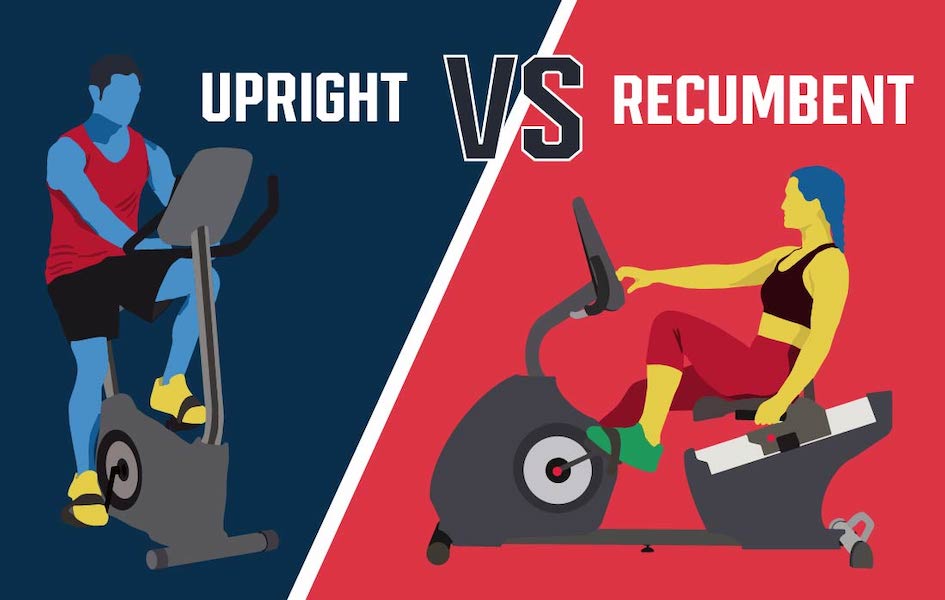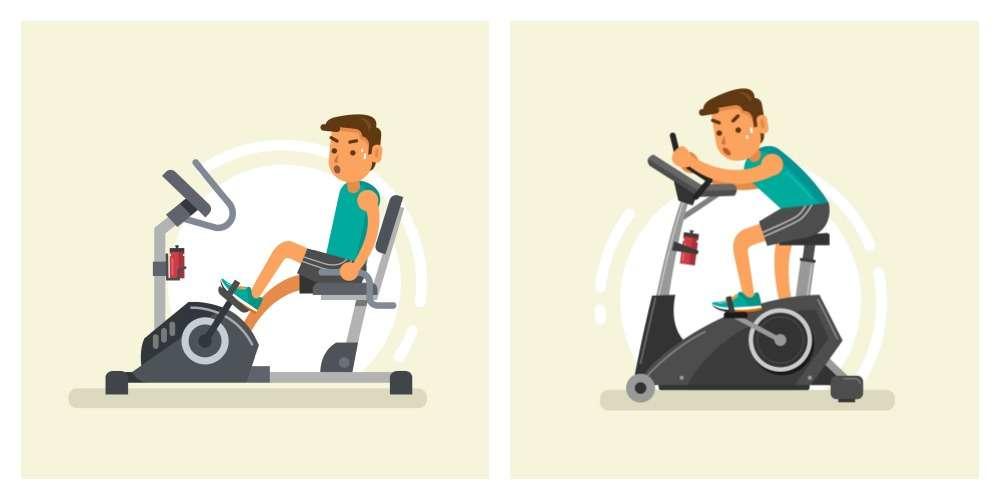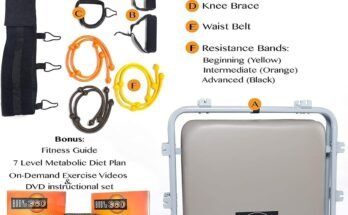If you’re dealing with knee issues or just want to protect your joints during workouts, choosing the right exercise bike matters more than you might think. Both recumbent and upright bikes are popular choices — but which one is actually better for your knees?
Each bike comes with its own set of benefits. Recumbent bikes are known for their supportive design, offering a laid-back position that takes pressure off your knees and lower back. Upright bikes, on the other hand, mimic the feel of a regular bicycle and activate a wider range of muscles, including those around the knees.
Finding the right fit depends on your body, comfort level, and fitness goals. In this post, we’ll break down how each bike type affects your knees and help you figure out which one aligns best with your needs. Whether you’re after a gentler ride or a more active challenge, understanding these differences can help you ride smarter and stay pain-free. Let’s get into it.
Introduction To Exercise Bikes
Exercise bikes provide an effective way to stay fit indoors. They offer a low-impact workout suitable for all ages. These bikes are popular for boosting cardiovascular health and toning muscles. Many people use them to maintain joint health without high-impact stress. Two main types of exercise bikes exist: recumbent and upright. Each has unique features and benefits. Choosing the right one can impact your knee health significantly.
Recumbent Vs. Upright
Recumbent bikes have a reclined seat with back support. This design reduces strain on the knees. Riders sit in a laid-back position, distributing weight more evenly. This position can be more comfortable for longer sessions. Upright bikes resemble traditional bicycles. They engage more muscles, providing a more intense workout. The upright design requires more knee movement. Some find this increases stress on the joints.
Popularity In Fitness
Both bike types are popular in gyms and homes. Recumbent bikes attract those with joint concerns or back issues. They offer a gentler ride and are often favored by older adults. Upright bikes appeal to those seeking a more challenging workout. Fitness enthusiasts enjoy the intense calorie burn they offer. Both types provide great cardiovascular benefits, making them staples in fitness routines.
Design And Structure
Choosing between recumbent and upright bikes depends on knee comfort. Recumbent bikes often reduce knee strain due to their reclined position, providing better support. Upright bikes engage more muscles, which might increase knee pressure but can be beneficial for strengthening.
When choosing between a recumbent or upright bike, the design and structure play a crucial role, especially for those concerned about knee health. Each bike type has distinct features that may affect how your knees feel during and after a workout. Understanding these differences can help you make an informed decision that aligns with your fitness goals and physical comfort.
Recumbent Bike Features
A recumbent bike offers a relaxed seating position. The seat is larger and provides back support, which is great for reducing stress on your knees. This design allows you to pedal with less pressure on your joints. The pedals are positioned in front of your body. This positioning promotes a more natural knee motion, which can be beneficial if you have knee pain or are recovering from an injury.
It allows you to exercise without putting too much strain on your knees. Many recumbent bikes come with adjustable seats. This feature ensures that you can find a comfortable position that minimizes knee strain. Have you ever tried adjusting a seat and noticed immediate relief? That’s the kind of benefit you can expect here.
Upright Bike Characteristics
An upright bike resembles a traditional bicycle. It requires you to sit in a more vertical position, which might engage more muscles but can also put more pressure on your knees. This design often appeals to those looking for a more intense workout. The pedals are located directly beneath your body. This positioning means your knees will bend more during pedaling, which can be challenging for those with sensitive knees. It’s essential to adjust the bike properly to avoid discomfort.
Upright bikes often have smaller seats. While this might not directly impact your knees, the overall comfort can affect how long and effectively you can work out. Have you ever cut a workout short because the seat was too uncomfortable? Proper bike setup can make a significant difference. When deciding on a bike for knee health, consider your comfort and any existing knee issues. Have you found that one design works better for you? Share your experiences and insights, as your story might help someone make their choice.
Impact On Knees
The choice between a recumbent or upright bike depends on knee health. Each bike offers unique benefits and impacts the knees differently. Understanding the mechanics and load distribution helps in making an informed decision.
Knee Joint Mechanics
Recumbent bikes position the rider in a reclined posture. This setup supports the back and distributes weight evenly. It reduces stress on the knee joints, providing a comfortable ride. Upright bikes mimic the natural cycling posture. This position engages the knees more actively. While it can enhance muscle strength, it may stress the knees for those with joint issues.
Load Distribution
Recumbent bikes shift weight away from the knees. The seat supports the back, allowing for even pressure distribution. This reduces the risk of knee pain. Upright bikes place more load on the knees. The upright position requires the knees to bear more weight. This can be challenging for those with existing knee problems.

Comfort And Ergonomics
Comfort and ergonomics are key factors in choosing a bike for knee health. Both recumbent and upright bikes offer unique benefits. Understanding their design can help you decide which fits your needs better.
Seat Design And Support
A recumbent bike has a large, cushioned seat. It provides excellent back support. This design reduces strain on knees and offers a relaxed riding experience.
An upright bike comes with a smaller seat. It requires more balance and core engagement. Some find this less comfortable for long rides.
Handlebar And Pedal Position
Recumbent bikes have handlebars at the sides. This ergonomic position allows easy grip and less shoulder strain.
Pedals are positioned forward, reducing knee stress. This setup helps maintain a smooth cycling motion.
Upright bikes feature handlebars at the front. This encourages a bent-over posture. It might cause discomfort over time.
Pedals are directly below the seat. This can increase knee pressure, needing careful adjustment.
Benefits For Knee Health
Knee health is crucial for maintaining mobility and quality of life. Choosing the right type of exercise can make a big difference. Recumbent and upright bikes offer unique benefits for knee health. Each type provides its own advantages. Understanding these can help in selecting the best option for your knees.
Low Impact Exercise
Recumbent and upright bikes offer low-impact exercise options. They reduce strain on the knees. This makes them ideal for people with knee issues. The smooth, circular motion minimizes stress on the joints. Less impact means less pain. It’s easier to enjoy longer workouts without discomfort.
Range Of Motion Enhancement
Using a recumbent or upright bike can improve the knee’s range of motion. The pedaling action helps in gently stretching the knee joint. This promotes flexibility and helps in recovery from injuries. Enhanced motion can lead to improved knee function over time. Regular use can maintain joint health and prevent stiffness.
User Experience And Feedback
When choosing between a recumbent and an upright bike for your knees, user experience and feedback can provide valuable insights. Personal experiences shared by users often paint a clearer picture of what you might expect from each option. Whether you’re recovering from an injury, managing arthritis, or simply aiming for comfort, understanding the experiences of others can guide your decision.
Recumbent Bike Reviews
Many users find recumbent bikes easier on the knees. The design allows you to sit in a reclined position, reducing strain on your joints. Users often mention feeling less pressure on their knees compared to upright bikes.
One user shared, “After my knee surgery, the recumbent bike was a lifesaver. It felt more comfortable, and I could cycle for longer without pain.”
Some reviews highlight the ease of getting on and off the bike, especially for those with limited mobility. This accessibility is often praised by older adults or those dealing with knee issues.
Upright Bike Opinions
Upright bikes offer a different experience, often likened to traditional cycling. Some users enjoy the familiar feel and find it beneficial for building leg strength.
A cyclist noted, “I prefer the upright bike because it mimics road cycling. My knees feel fine, and I get a great workout.”
However, others mention discomfort, particularly if the seat is not adjusted correctly. Ensuring proper alignment can make a significant difference in knee comfort.
If you’re torn between these options, consider your own preferences and any knee concerns. Which bike aligns with your fitness goals and comfort needs?
Ultimately, your choice may depend on specific knee health considerations. Have you tried either bike, and what was your experience? Share your thoughts to help others make informed decisions.
Considerations For Knee Issues
Choosing between a recumbent and an upright bike can affect knee health. Each type offers unique benefits and challenges for those with knee concerns. Understanding these differences can help make an informed decision. Let’s explore the key considerations for knee issues when choosing a bike.
Injury Prevention Tips
Proper bike setup is crucial for preventing knee injuries. Adjust the seat height to allow a slight bend in the knee at the bottom of the pedal stroke. This reduces strain on the knee joint. Make sure the pedals align with your feet. This alignment prevents unnecessary twisting and strain.
Warm up before cycling to prepare your muscles and joints. A gentle stretch can also help. Start with low resistance and gradually increase it. Avoid pushing too hard too soon. Listen to your body and rest if you feel pain or discomfort.
Recommendations For Knee Pain
For knee pain, a recumbent bike may offer more comfort. It provides back support and places less stress on the knees. The reclined position can also reduce pressure on the joints. Upright bikes are good for building strength. They engage more muscles, which can improve knee stability.
Consult a doctor or physical therapist for personalized advice. They can recommend the best bike type based on your specific knee condition. Regular check-ins can track progress and adjust the plan as needed. Remember, consistency is key for improvement.

Conclusion And Recommendations
Choosing between a recumbent or upright bike depends on knee comfort and support. Recumbent bikes provide better back support, reducing knee strain. Upright bikes engage more muscles, which can benefit overall leg strength.
Choosing the right exercise bike for your knees is crucial. Both recumbent and upright bikes offer unique benefits. Recumbent bikes provide back support. They reduce pressure on the knees. Upright bikes engage more muscle groups. They offer a more intense workout.
Choosing The Right Bike
Consider your fitness goals. Do you seek comfort or a challenging workout? Recumbent bikes suit those with knee pain. They offer a gentler ride. Upright bikes benefit those aiming for intense exercise. They engage the core and upper body. Evaluate your current fitness level.
Personal Preferences And Needs
Personal preferences matter in bike choice. Do you prefer a relaxed position? Choose a recumbent bike. Want a more traditional cycling experience? An upright bike fits better. Consider your space at home. Recumbent bikes often take more space. Upright bikes are more compact. Assess your budget as well. Both bike types vary in price. Aim for comfort and efficiency. “`

Frequently Asked Questions
Is An Upright Or Recumbent Bike Better For The Knees?
Recumbent bikes are usually gentler on the knees due to their reclined position and back support. They minimize strain and provide a comfortable workout. Upright bikes may put more pressure on the knees, but they offer a more traditional cycling experience.
Consider personal comfort and knee health when choosing.
What Are The Disadvantages Of A Recumbent Bike?
Recumbent bikes can be expensive and bulky, requiring more space. They offer limited upper body workout and may be difficult to transport. Visibility on roads can be a concern for outdoor use, and adjusting to the reclined position might take time for new users.
What Type Of Bike Is Best For Bad Knees?
A recumbent bike is best for bad knees. It offers a comfortable seat and reduces knee strain. The reclined position and lower impact pedaling provide gentle exercise, minimizing joint stress. It’s ideal for those with knee pain seeking low-impact cycling options.
Can You Ride A Recumbent Bike With Bad Knees?
Riding a recumbent bike is often suitable for individuals with bad knees. It provides low-impact exercise, reducing joint stress. Consult your healthcare provider to ensure it fits your specific needs. Adjust the seat and handlebars properly for comfort and support during your workout.
Conclusion
Both recumbent and upright bikes offer knee-friendly exercise options. Choose based on comfort and goals. Recumbent bikes provide more back support and less knee strain. Upright bikes mimic outdoor cycling, offering an intense workout. Listen to your body. Consult a doctor if unsure about your knees.
Start slowly to avoid injury. Regular exercise strengthens muscles supporting the knees. Both bikes can improve joint health over time. Finding the right fit makes cycling enjoyable and beneficial. Keep moving for healthier knees.



